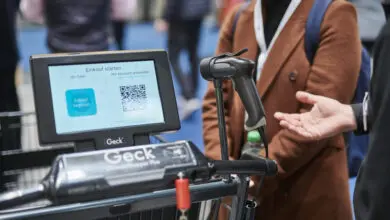Guest Feature: Unified Commerce is no longer optional – Here’s why retailers must adapt now

If a delivery ordered online does not arrive on time or communication does not run smoothly, customer satisfaction drops immediately – and shoppers simply switch to competitors. To avoid such frustrations and provide a seamless experience, companies need to act now. This applies to both the online store and background processes such as warehouse logistics, which is a key factor for success.
E-commerce is a strong growth driver in the German retail sector: in 2024, German retailer association Handelsverband Deutschland (HDE) recorded sales of 88.4 billion Euros. By 2025, this figure is expected to reach 91 billion Euros. What does this mean for the market?
As the market grows, so does the pressure. Competition is increasing, and customers today expect more than just a web store – they want a seamless experience from first click to delivery. If companies don’t provide that, they will lose customers to their competitors. That’s why it is so important to act now and optimise processes to be well positioned for the future.
Increasing pressure on the e-commerce market
The gap between customer expectations and reality is also widening because digital and physical retail are still insufficiently connected. Too often, customers who first browse the online shop and then visit a physical store realise that the dialogue starts from scratch each time. Ultimately, the goal is to create a unified customer experience, where every sales and communication channel works seamlessly together.
Those who test, adapt and roll out appropriate omnichannel, supply chain, order management and point-of-sale solutions across the company will reduce inventory risks and increase their turnover across all sales channels. When companies fail to act, they pay a high price – often without even realising it. Poorly optimised supply chains lead to unused stock, excess stock in the wrong regions, and ultimately to dissatisfied customers. The result is loss of sales.
The power of the online store
A key factor for preventing such problems is warehouse logistics. After all, your own warehouse is the linchpin of the supply chain. A quickly scalable warehouse management system is indispensable for reacting to strongly fluctuating demand as well as increasing productivity and efficiency. The software also plays an important role in always providing a reliable overview of stock levels and organising employees correctly.

The front end of the entire supply chain, and therefore an important lever in increasing customer satisfaction, is the web store. A well-optimised product page can significantly boost engagement and sales. Customers expect more than just a product photo, they want to know their size is in stock nearby and can be delivered by tomorrow.
Standardised view of inventories, sales data and customer preferences
In Germany, mobile commerce is an increasingly important topic: according to Statista, around 80 per cent of Germans currently use their smartphone for online shopping. Web stores must therefore be optimised for mobile use, and accessibility is also becoming increasingly important. However, most German online stores are not prepared for the upcoming legal requirements for accessibility. Accessible stores reach more people and keep them happier.
That’s where solutions like Manhattan Active Omni come in. It’s a cloud-native platform that connects online, mobile and in-store channels. It provides a unified view of inventory, sales data and customer preferences, so companies know exactly where their products are and how best to get them to the customer. This in turn ensures a lower picking error rate, shorter order turnaround time, faster returns restocking and shorter customer service response times. The result is a seamless customer journey that delights customers and increases conversion rates.

What customers really want
The most important keyword is control. Customers want to manage their orders themselves. Digital self-service functions are the key here. Anyone ordering online should be able to track the shipment, register a return or change the delivery address with just one click. Such functions have long been part of any future-proof omnichannel offering.
That’s where Manhattan Active Maven comes in, an advanced solution that uses generative AI to fundamentally improve customer service. Manhattan Active Maven is the first GenAI chatbot that has native access to orders, payments, store locations and product availability. It can provide personalised, contextual responses – almost like a human. Companies don’t need to set up complicated scripts – they simply integrate the bot into their website and it is ready to go. This increases customer satisfaction and reduces operating costs because fewer customer service staff are needed.
Hugo Boss, Cool Blue and Suit Supply optimise their processes with Manhattan
And how do you ensure that the parcels arrive on time? Supply chain planning with AI helps with this. Manhattan’s modern systems use artificial intelligence to make data-based decisions. They determine what stock to send where, and when, in order to avoid overstocking. The result: products are exactly where they are needed – and that increases margins and customer satisfaction.

Successful retailers such as Hugo Boss, Cool Blue and Suit Supply have long relied on Manhattan’s revolutionary solutions – including components of the Manhattan Active platform, a cloud-native technology based on microservices.
On the cutting edge
Sustainability will remain a major trend in 2025. 45 per cent of shoppers say that it is a decisive criterion when choosing a retailer. A study by the German Association for E-Commerce and Mail Order bevh shows that delivery to parcel stations or stores generates 49 per cent fewer greenhouse gas emissions than doorstep delivery – an option that customers could make more use of if stores were to advertise it. At the same time, `Buy Now, Pay Later´ (BNPL) is gaining popularity. 39 per cent of 18 to 29-year-olds in Germany use BNPL for spontaneous purchases. Across all age groups, this payment model is attractive for amounts of 100 Euros or more. Customers obviously want flexibility – in terms of payment and delivery.
Manhattan Active Omni can contribute to greater sustainability by helping minimise excess stock. Online orders, for example, can be passed on to underperforming. This allows retailers to reduce their `dead´ stock without having to offer discounts on goods in-store.
Personalisation and the future of e-commerce
Manhattan’s Unified Commerce Benchmark 2025 shows that companies that are leaders in unified commerce achieve up to three times higher sales growth and 1.7 times customer lifetime value. With solutions like Manhattan Active Omni, retailers can create personalised shopping experiences. The platform provides a 360-degree view of customer interactions – whether they are shopping on the website, in the app or in the store. This makes it possible to address customers at a more individual level and provide them with better advice.
Social commerce is a megatrend in e-commerce in Germany. According to forecasts by Statista, more than 17 per cent of online sales will be made via social networks by 2025. Voice control is also becoming increasingly important: one in five German online users already shops by voice command, and sales with voice commerce are set to increase further in 2025. This means that stores need to be optimised for voice assistants such as Alexa or Google Assistant. Manhattan Active Omni helps to make the most of these trends. The platform integrates social commerce channels and offers interfaces for voice control so that companies can meet their customers where they are. This allows companies to fully exploit their potential and increase customer loyalty.
Omnichannel has long been a reality – but not implemented well everywhere
Customers expect a shopping experience that is fast, transparent and consistent. Long loading times in the web store, a lack of real-time information on stock levels or poor integration of online and store stock lead to frustration and abandoned purchases. The technology to change this is at hand: from machine learning for precise delivery times to self-service functions and AI-supported supply chain planning. Solutions like Manhattan Active Omni and Manhattan Active Maven go one step further: they unite all channels, offer scalability, reduce operating costs and enable personalised customer experiences. The real challenge isn’t the competition, it’s companies’ hesitation to optimise their own processes.




